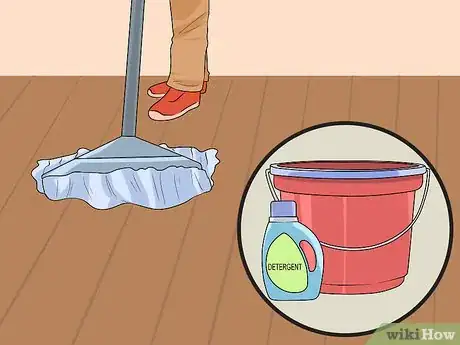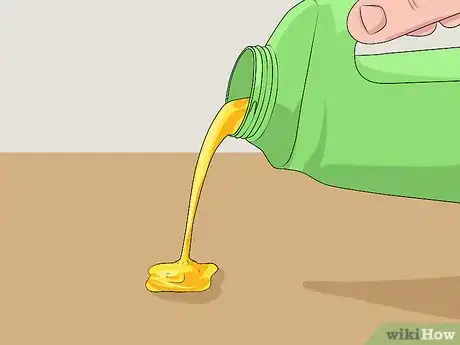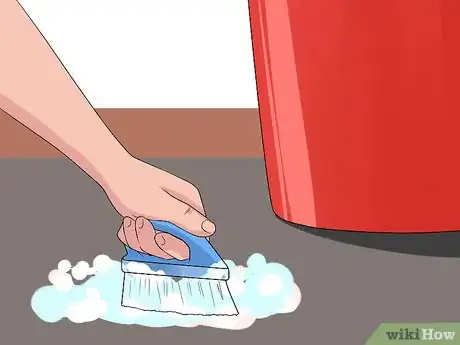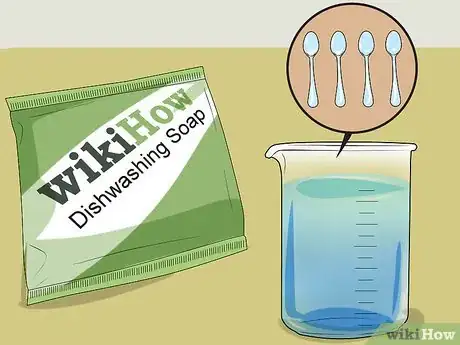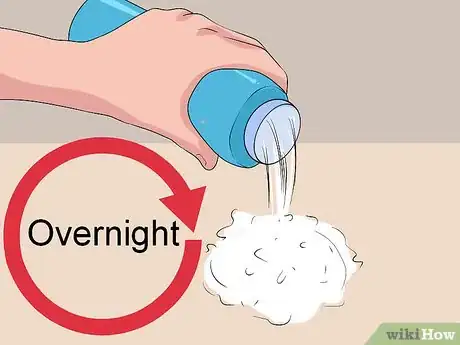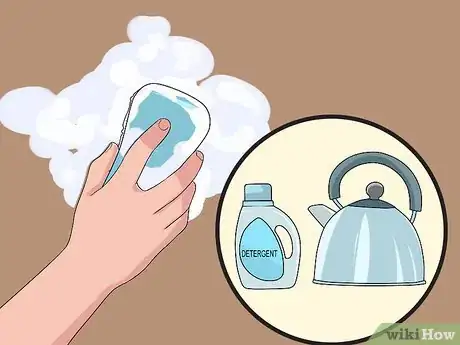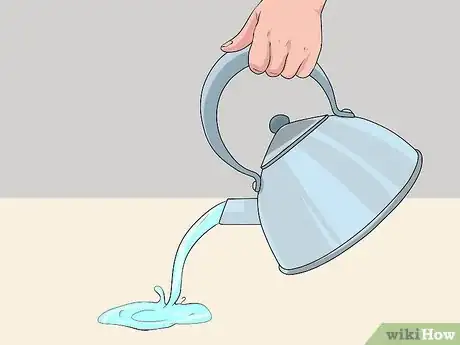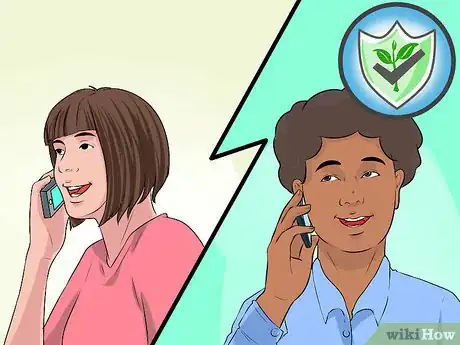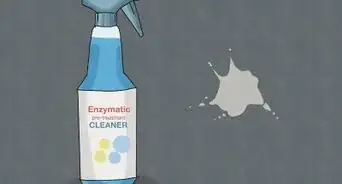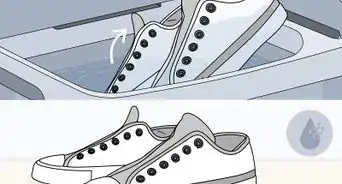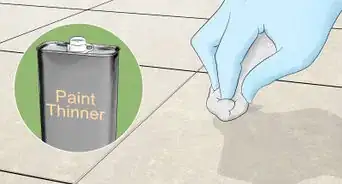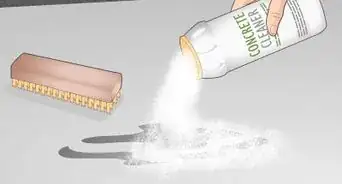This article was co-authored by Michelle Driscoll, MPH. Michelle Driscoll is the Owner of Mulberry Maids, which is based in Fort Collins, Colorado. With five years of experience, her business specializes in cleaning homes and small offices. She holds a Masters in Public Health from the Colorado School of Public Health. Additionally, Mulberry Maids has an A+ rating from the Better Business Bureau.
There are 8 references cited in this article, which can be found at the bottom of the page.
This article has been viewed 70,662 times.
Whether you’re cleaning up a spill that came from cooking oil, paint, or motor oil, oil spills should be handled differently than other spills. You should never scrub an oil stain because it will spread. The types of oil may differ, but typically you will need an absorbent material and dish detergent to clean the spill. If you tackle it quickly and with the proper tools, you should be able to completely clean up the spill.
Steps
Cleaning Cooking Oil Spills
-
1Pick up pieces of glass. Glass can be a problem if you dropped the bottle that contained the oil. If glass is present in the spill, use garden gloves or ice cube tongs to pick up the pieces. Cover the glass in newspaper before putting it in the trashcan.[1]
- Wear shoes with rubber soles while cleaning up the glass.
-
2Cover the area with an absorbent material. You can use salt, kitty litter, corn starch, sand, or oatmeal as the absorbent material. Pour the material over the entirety of the spill. Allow the material to sit on the spill for about fifteen minutes.[2]
- You can blot up some of the spill with paper towels before applying the absorbent material. You won’t need as much material if you blot up the spill first.
Advertisement -
3Scoop up the absorbent material. You can use paper towels or a spatula to do this. Do not use a vacuum cleaner or mop at this point. Continue to scoop up the material until the absorbent material and oil is gone.[3]
-
4Wipe up the leftover residue. Use paper towels or slices of bread to wipe up the oil residue. You should be able to remove most of the residue. Don’t worry if the floor is slightly sticky when you’ve removed most of the residue.[4]
-
5Mop up the floor. Use a grease-fighting dish detergent when you mop. Combine the detergent with warm water. Go over the area where the spill was until the floor is clean and free of residue.[5]
Using Detergent for Oil Paint Spills
-
1Pour dish detergent on the spill. You can blot up some of the oil with paper towels to begin before using the detergent. Use a grease-fighting dish detergent. Squirt a liberal amount of the detergent over the spill.
-
2Scrub the area. Apply some water and begin to scrub the area. If the floor hasn’t been stained yet, you can use a cleaning brush. If some staining has occurred, use a rag. Scrub gently to avoid scratching the floor.
-
3Apply more soap and water. You will probably have to apply more soap and water as you scrub up the oil paint. Do not use a lot of water when you apply more to the spill. Only apply about four tablespoons of water. Continue to scrub until the floor becomes clean and shiny.
- You may have to scrub for a while for the spill to lift completely.
Removing Oil Spills on Concrete
-
1Sprinkle powder over the spill. You can use baby powder or talcum powder. Use cat litter if the spill is large. Spread the powder over the spill with a broom. Allow it to sit overnight.[6]
-
2Use a concrete cleaner or strong degreaser, as an alternative. You can find cleaners formulated for use on concrete, including some formulated to treat oil or grease. Alkaline cleaners are especially helpful for cleaning up this kind of spill.[7]
- Use the concrete cleaner or degreaser as an alternative to powder, not in addition to it.
-
3Sweep up the residue. Use a broom to sweep up the powder after you have let it sit overnight. Most of the oil should have been absorbed at this point. You can use paper towels to blot up remaining residue.[8]
-
4Wash with detergent. You can use grease-fighting dish detergent, or you can use laundry detergent. Combine the detergent with hot water. You can let the detergent sit on the spill for about an hour if residue remains. Use a mop or a cleaning brush to wash the area.
-
5Rinse with hot water. Use warm water to rinse off the detergent and remaining oil. The concrete should be clean at this point. You can repeat the process if any oil remains.
Helping with Environmental Disasters
-
1Take preventative measures. Drilling is one large factor that contributes to oil spills. Contact legislators in your state and ask them to vote for bills that ban drilling and any other environmentally friendly policies. You can also sign petitions calling for your state representatives to sign environmentally friendly bills.[9]
-
2Volunteer your help. Google “oil spill volunteers” to see what organizations are asking for volunteers. Call the organization and ask how you can help. In some instances, like caring for animals, only qualified professionals will be able to help. For other volunteering opportunities, like administrative help, volunteers may have to be trained. Untrained volunteering opportunities, like picking up trash, should be abundantly available.[10]
- Do not try to help wildlife unless you have the permission and knowledge to do so.[11]
- The Audubon Society, which protects birds and their habitats, is one place that you can contact for volunteering opportunities.
-
3Report injuries and damage. If you are in the area where the oil spill occurred, call the local authorities to report injuries and damage that you feel has gone unnoticed. It is likely that there will be a hotline specifically for injured and dead animal sightings, but it will change depending on the event and location. Do not try to help injured animals unless you are qualified to do so.[12]
-
4Donate to organizations. In some cases, a donation is more helpful and preferred over volunteering. A couple of places you can donate to are the National Wildlife Federation and the Save Our Seabirds organization. During oil spills, companies like Dawn will donate a portion of your purchase to help the clean up effort.[13]
Warnings
- Do not scrub the oil without a cleaning product on it. You will only spread the stain.[17]⧼thumbs_response⧽
Things You’ll Need
- Absorbent material (corn starch or kitty litter)
- Paper towels
- Towels
- Dish detergent
- Mop
- Bucket
- Talcum powder
- Broom
References
- ↑ http://www.howtocleanstuff.net/how-to-clean-a-cooking-oil-spill/
- ↑ http://onecreativemommy.com/how-to-clean-up-oil-spill-in-the-kitchen/
- ↑ http://www.howtocleanstuff.net/how-to-clean-a-cooking-oil-spill/
- ↑ http://www.howtocleanstuff.net/how-to-clean-a-cooking-oil-spill/
- ↑ http://www.howtocleanstuff.net/how-to-clean-a-cooking-oil-spill/
- ↑ http://www.huffingtonpost.com/2012/05/24/how-to-clean-oil-concrete_n_1542783.html
- ↑ https://www.concretenetwork.com/concrete-cleaner/
- ↑ http://www.huffingtonpost.com/2012/05/24/how-to-clean-oil-concrete_n_1542783.html
- ↑ http://www.patagonia.com/blog/2015/06/how-to-prevent-oil-spills/
- ↑ http://money.usnews.com/money/blogs/fresh-greens/2010/05/03/10-things-you-can-do-to-help-the-gulf-coast-clean-the-oil-spill
- ↑ http://money.usnews.com/money/blogs/fresh-greens/2010/05/03/10-things-you-can-do-to-help-the-gulf-coast-clean-the-oil-spill
- ↑ http://money.usnews.com/money/blogs/fresh-greens/2010/05/03/10-things-you-can-do-to-help-the-gulf-coast-clean-the-oil-spill
- ↑ http://money.usnews.com/money/blogs/fresh-greens/2010/05/03/10-things-you-can-do-to-help-the-gulf-coast-clean-the-oil-spill
- ↑ https://www.cleanipedia.com/gb/laundry-washing/how-to-remove-oil-stains-from-clothes
- ↑ http://www.howtocleanstuff.net/how-to-clean-a-cooking-oil-spill/
- ↑ http://www.howtocleanstuff.net/how-to-clean-a-cooking-oil-spill/
- ↑ http://www.huffingtonpost.com/2012/05/24/how-to-clean-oil-concrete_n_1542783.html
About This Article
To clean up cooking oil spills in the kitchen, cover the area with an absorbent material, such as salt, kitty litter, corn starch, sand, or oatmeal. Allow it to sit for 15 minutes, then use paper towels or a spatula to scoop up the mess, and wipe up any leftover residue. If the area is still sticky or slick, mop it with a grease-fighting dish detergent. Alternatively, to clean up an oil paint spill, pour dish detergent on the affected area, add a small amount of warm water, and scrub it clean. To learn how to remove oil spills from concrete, keep reading!




